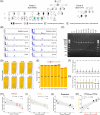Repeat Expansions with Small TTTCA Insertions in MARCHF6 Cause Familial Myoclonus without Epilepsy
- PMID: 40200849
- PMCID: PMC12273606
- DOI: 10.1002/mds.30192
Repeat Expansions with Small TTTCA Insertions in MARCHF6 Cause Familial Myoclonus without Epilepsy
Abstract
Background: Familial adult myoclonus epilepsy (FAME) is a rare autosomal dominant disorder caused by the same intronic TTTTA/TTTCA repeat expansion in seven distinct genes. TTTTA-only expansions are benign, whereas those containing TTTCA insertions are pathogenic.
Objective: We investigated the genetic basis of dominant cortical myoclonus without seizures in two unrelated families.
Methods: Repeat-primed polymerase chain reaction (PCR), long-range PCR, and nanopore sequencing were used to detect and characterize expansions at known FAME loci.
Results: We identified a novel repeat expansion in MARCHF6, comprising 388 to 454 elongated TTTTA repeats and 5 to 11 TTTCA repeats at the 3'-terminus, segregating with cortical myoclonus in 8 affected individuals. This configuration shows meiotic stability but low-level somatic variability in blood. We observed an inverse correlation between the number of TTTCA repeats and the age at myoclonus onset.
Conclusions: These findings indicate that as little as five TTTCA repeats combined with expanded TTTTA repeats can cause cortical myoclonus without epilepsy, highlighting the potential mechanisms underlying FAME pathophysiology. © 2025 The Author(s). Movement Disorders published by Wiley Periodicals LLC on behalf of International Parkinson and Movement Disorder Society.
Keywords: MARCHF6; epilepsy; familial adult myoclonus epilepsy (FAME); myoclonus; repeat expansion.
© 2025 The Author(s). Movement Disorders published by Wiley Periodicals LLC on behalf of International Parkinson and Movement Disorder Society.
Figures

Similar articles
-
[Molecular genetics of benign adult familial myoclonus epilepsy].Rinsho Shinkeigaku. 2025 Jul 25;65(7):495-502. doi: 10.5692/clinicalneurol.cn-002111. Epub 2025 Jun 26. Rinsho Shinkeigaku. 2025. PMID: 40571639 Review. Japanese.
-
First clinical diagnosis of FAME3 via commercial Long-Read sequencing reveals mosaic repeat expansion in MARCHF6 gene.Neurogenetics. 2025 Aug 11;26(1):61. doi: 10.1007/s10048-025-00835-6. Neurogenetics. 2025. PMID: 40788430 Free PMC article.
-
Origin and evolution of pentanucleotide repeat expansions at the familial cortical myoclonic tremor with epilepsy type1 - SAMD12 locus.Eur J Hum Genet. 2025 Mar;33(2):252-257. doi: 10.1038/s41431-024-01586-y. Epub 2024 Mar 12. Eur J Hum Genet. 2025. PMID: 38467733
-
Unstable TTTTA/TTTCA expansions in MARCH6 are associated with Familial Adult Myoclonic Epilepsy type 3.Nat Commun. 2019 Oct 29;10(1):4919. doi: 10.1038/s41467-019-12763-9. Nat Commun. 2019. PMID: 31664039 Free PMC article.
-
Genetics of familial adult myoclonus epilepsy: From linkage studies to noncoding repeat expansions.Epilepsia. 2023 Jun;64 Suppl 1(Suppl 1):S14-S21. doi: 10.1111/epi.17610. Epub 2023 Apr 17. Epilepsia. 2023. PMID: 37021642 Free PMC article. Review.
References
-
- Striano P, Zara F, Striano S. Autosomal dominant cortical tremor, myoclonus and epilepsy: many syndromes, one phenotype. Acta Neurol Scand 2005;111(4):211–217. - PubMed
-
- van Rootselaar AF, van Schaik IN, van den Maagdenberg AM, Koelman JH, Callenbach PM, Tijssen MA. Familial cortical myoclonic tremor with epilepsy: a single syndromic classification for a group of pedigrees bearing common features. Mov Disord 2005;20(6):665–673. - PubMed
MeSH terms
Substances
Supplementary concepts
Grants and funding
LinkOut - more resources
Full Text Sources

